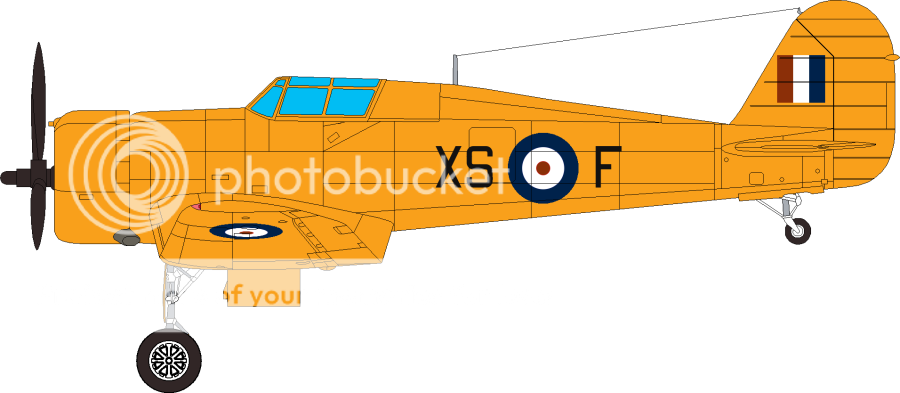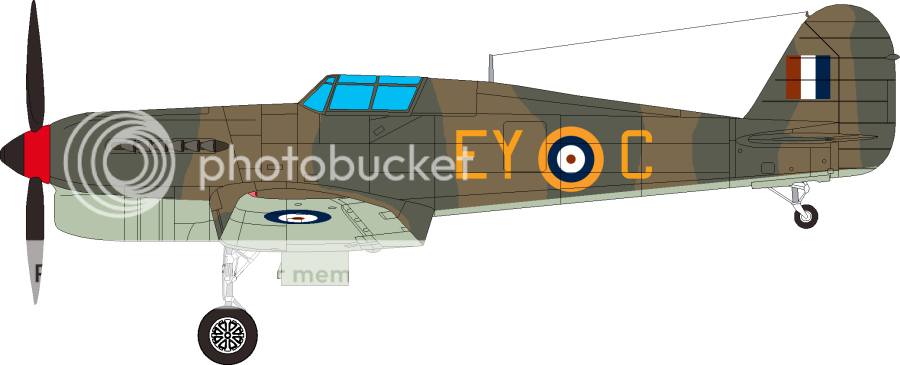I was debating how to present the rest of the Skemcis family, finally I decided to do it chronologically. So, here goes! :) (And my previous reference to credit for engines going to Apophenia *really* becomes valid from here on out!)
Even as the Mk. II and Mk. III were getting into production, Supermarine BC was busy at work on a new variant of the Skemcis, with retractable undercarriage, four Hispano Mk. II cannon and - important especially for operation outside of southwestern BC - an enclosed cockpit. Not one but two prototypes were built and tested in 1937...

Designated
Skemcis (F) Mk. IV, the first of the prototypes retained the Wright Cyclone F.3 of the previous versions. The XS "unit code" on this and other prototype aircraft wasn't truly an RBCAF unit code, rather the air force assigned X(x) ID codes to aircraft being tested by or for the aircraft; the second letter of the code identified the manufacturer, thus "XS" can be defined as "eXperimental Supermarine".
Vancouver-based Hoffar-Beeching Shipyards got into the aero engine business in 1923, quickly establishing a division, Hoffar Aero Engines, to specialise in the manufacture and development of aircraft engines. In 1934, HAE obtained a licence from Société Lorraine to manufacture the Mizar and Algol radial engines in BC, which established a relationship between Hoffar and Lorraine. In 1936, HAE introduced the HLV-12A Petrel, a North Americanised version of the Lorraine 12H Pétrel glycol-cooled upright V-12, which developed 1700 hp, had direct fuel injection, 5.71" x 5.71" bore and stroke and had a dry weight of 1090 lbs.

The second of the prototypes, the
Skemcis (F) Mk V was identical to the Mk. IV in all respects, except it replaced the Wright radial with Hoffar's latest version of the Petrel series, the HLV-12A-2. Instead of fuel injection it had an updraught Bendix carburettor and developed 800 hp, but was otherwise identical to the 12A (though the 12A-2 was 10 pounds heavier).
The RBCAF evaluated both prototypes, and was quite pleased with both. In the end, it was decided that the Petrel-engined variant was the better option; it was not an insignificant factor in the decisionmaking process that the Petrel was built in BC, and not sourced from a foreign - and potentially hostile (given tensions over the Alaska-BC border) - source.

The RBCAF thus placed an order in early 1938 for eighty
Skemcis F Mk. VI fighters from Supermarine. Slightly different from the Mk. V prototype, the Petrels fitted to the production F Mk. VI were rated at 880 hp, and revised the armament fit to two Hispano Mk. II cannon and four Browning machine guns. Seen here is a Mk. VI of No. 2 Sqn RBCAF some time between 1938 and 1941.

The Royal BC Navy had been watching the progress of the Skemcis project with great interest as well, and after the RBCAF decided on productionising the Hoffar-engined Mk. V prototype, the FAA commissioned Supermarine to devise a floatplane variant for use by the RBCN as a patrol fighter. Supermarine's long experience with seaplane design and its long-standing relationship with Hoffar made this project go smoothly and quickly, and the first prototype
Sea Skemcis SF Mk. I was ready inside six months. It was fitted with the same Petrel engine as on the RBCAF's F Mk. VI, but it retained the four Hispano cannon of the Mk. V prototype. A two-float version was briefly considered, but in the end Supermarine's engineers decided a single, main central float with smaller pontoons under the wings would be a more suitable layout for a fighter. The Navy was well pleased with the prototype and promptly placed an order for twenty, with delivery starting in May of 1939. The production version was designated SF Mk. I B; the first ten were stationed at Skidegate on the Queen Charlotte Islands and operated as part of the RBCN's "White Fleet" (the RBCN divided its operations into two regions, North Coast and South Coast; the North Coast operations were designated "White Fleet", while the south coast was "Blue Fleet"), while the second ten operated out of Port Hardy on Vancouver Island. The SF Mk. I were used to patrol the central and north coast where sparser population or other conditions made it difficult or undesirable (for various reasons) to establish permanent air force or navy bases. Operating out of Skidegate, the fighters were able to quickly respond to occasional American harassment of BC fishing boats in disputed waters, and for a time (that is, until the USN could respond by posting float-fighters of their own in the area), BC fishermen took all advantage of the air superiority, oftentimes going into water that even the BC government acknowledged as Alaskan (and claiming navigational error if called out on it). This activity - and harassment by both sides of the others' ships - was reduced significantly after the arrival of USN Vought Kingfishers to Alaska.
Apart from wing-wagging the Sea Skemcis never got into any sort of entanglement with the Kingfisher (...but in the opinion of this historian, the Grizzlies would've wiped the floor with the Kingfishers!

)